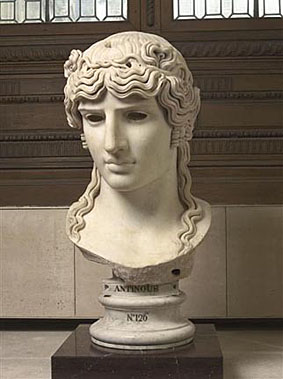Antinous Mondragone (c.130 AD).
Antinous: the face of the Antique
Main Galleries, Henry Moore Institute, Leeds
Exhibition: 25.05.06 – 27.08.06
The Emperor Hadrian’s young lover was Antinous, a beautiful youth who drowned mysteriously in the Nile before his 20th birthday. The Emperor, in his grief, commissioned busts and statues of his beloved, and as the cult of Antinous spread throughout the Roman Empire, many more were erected by his subjects.
Today Antinous has more sculptures to his name than almost any other figure from classical antiquity. The earliest of these finds were identified by comparison to tiny coin-portraits, each with an identifying legend, so that by the sixteenth century his aquiline nose and full lips were well known. Yet such was his appeal that as more and more heads, busts and statues were unearthed, there was a temptation to call those of any young pretty boy “Antinous”. Into the modern age, archaeologists and scholars have worked studiously to define the corpus of Antinous portraiture, basing their identification primarily on his hairstyle.
Drawing together loans from all over Europe, this is the first exhibition dedicated to Antique sculpture to be held at the Institute and the first in Britain to explore the mythical image of Antinous. As a subject, Antinous works not only to provide a very human way into looking at Antique sculpture, but also as an introduction to some of the thorniest issues surrounding work of this period. Issues of recognition, restoration and re-naming are all present, and to a degree we can deal with these by simply asking: does it look like him?
This exhibition has been selected by Dr Caroline Vout, of the University of Nottingham, and will be accompanied by a fully illustrated catalogue, with essay and entries by Dr Vout, along with extracts from more historical texts.
Elsewhere on { feuilleton }
• The gay artists archive


might be worth updating that the catalogue was published, is available in various libraries, and if not known about, LibraryThing and WorldCat are really easy ways about finding out about the existence of books and their whereabouts in libraries… it is only when you touch on classication that you will hit trouble, so gay art is not a good concept and this makes this site wonderful.. congratulations on so much work.